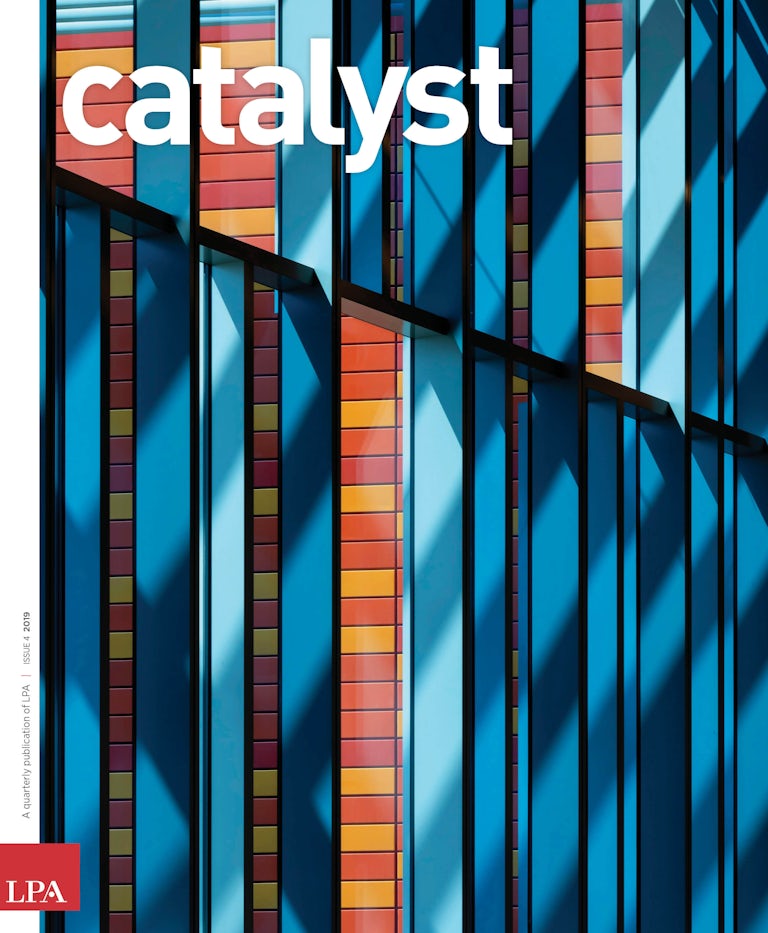The Boerne Independent School District in south-central Texas had very specific goals when it set about creating the new Van Raub Elementary School. Teachers and administrators were moving away from traditional classrooms in favor of more open, flexible spaces. They wanted to focus on team-based learning, in indoor and outdoor settings, where they could mix different ages and classes as instructional needs dictated.
LPA’s design for Boerne’s Fabra Elementary School, which opened in August 2016, served as a template for the 800-student, 42-classroom Van Raub campus. Opened in 2018, the two-story school is organized around a tiered courtyard that uses the site’s natural topography. Spaces are organized into “learning neighborhoods,” with an easy flow from interior rooms to collaborative hallway settings to the outdoors.
Hallways include spaces with smart boards for active, team-based learning, as well as areas for quiet, reflective study. Interior windows add to transparency and interactions. Outdoor areas with sinks are designed to encourage exploration into science and nature.
“The clustering of teaching spaces around collaborative spaces was a direct result of what we learned about the district’s evolving instructional style,” says LPA Project Architect Jim Oppelt, who managed the Van Raub project. “These spaces are pretty non-traditional for Texas campuses.”
Texas School Embraces 'Learning Neighborhoods'
Van Raub Elementary School focuses on 21st century learning environments, while preserving a 135-year-old schoolhouse.

The Van Raub design incorporates a German schoolhouse from 1885—set a short distance from the main campus—that served as the center of the historic Van Raub community, established in the 1880s as an enclave for German immigrants. LPA performed restoration on the old schoolhouse, which functions as a community space for voting and other uses. The district plans to develop a curriculum so that students from other campuses can spend a day learning about the region’s immigrant history.
Connection to the local heritage can be found throughout the campus. The new school’s exterior incorporates materials that have long been used in the Texas Hill Country, including locally quarried limestone for the entrance and low portions of walls, to match the historic one-room schoolhouse. Some walls feature ochre-colored bricks like those that regional builders have used for decades. Metal roofing, overhangs and awnings reflect heat and provide shade in the arid climate. Drought-resistant cedar elms provide shaded areas.

In the courtyard of the nearly 99,000-square-foot school, an 800-gallon tank catches condensation from the school’s air conditioners; the captured water is used to irrigate the campus vegetation. A four-pipe heating and cooling system increased energy efficiency and saved operational costs. Buildings are oriented to capture natural light and provide shade in the worst part of the day in Texas’ notoriously hot months.The campus includes a student garden and covered outdoor dining spaces where parents can meet with their children. Behind the school building, there are coops with 10 laying hens, part of a program funded by a local wildlife education committee. Kindergarten pupils monitor the hatching of fertilized eggs. Fourth-graders tend to the chickens, providing fresh water and food and learning about predators. Midnight, Angel, Goldilocks and other hens provide about eight eggs a day, which the students collect and distribute to staff members.

From the beginning, students instinctively appeared to understand the design’s potential. They get up and move around, pushing wheeled furniture into configurations as they see fit. It took the teachers some time to embrace the changes, says Jamie Robinson, Van Raub’s Principal. “We had to train the staff to use the design,” he says.
After a year, Robinson has seen changes in the school. Pupils enjoy the cheery library, which he describes as an “internet café.” Discipline has become less of a problem, Robinson says. The design has helped change behaviors. “I believe it’s because the kids are more engaged,” he says.
This story originally appeared in Catalyst Issue 4 2019. Subscribe today to receive Catalyst, a quarterly publication that takes a deep dive into design ideas, industry leaders and initiatives.















